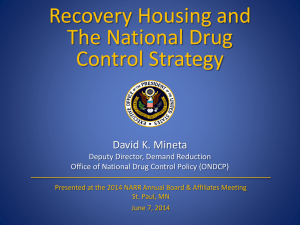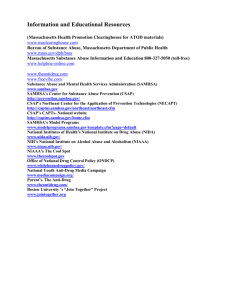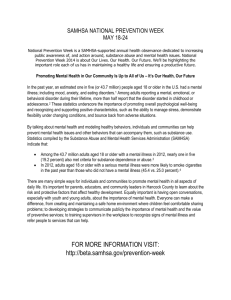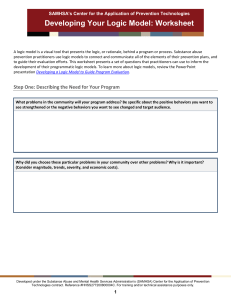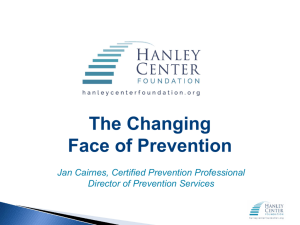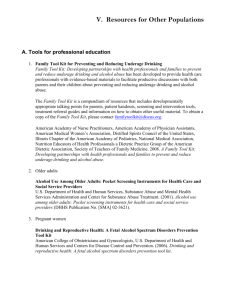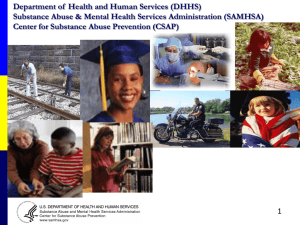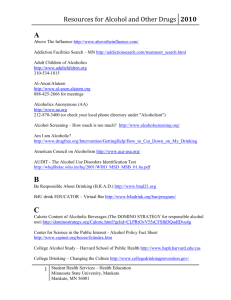FY 2014 Federal Appropriations for Mental Health Services and
advertisement
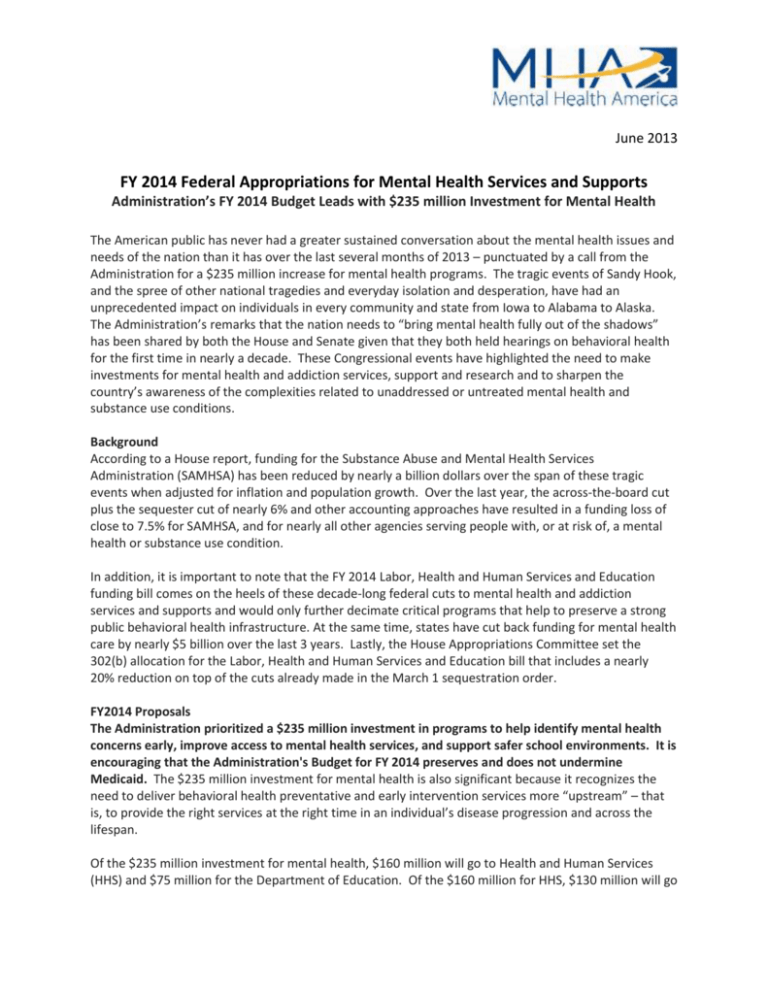
June 2013 FY 2014 Federal Appropriations for Mental Health Services and Supports Administration’s FY 2014 Budget Leads with $235 million Investment for Mental Health The American public has never had a greater sustained conversation about the mental health issues and needs of the nation than it has over the last several months of 2013 – punctuated by a call from the Administration for a $235 million increase for mental health programs. The tragic events of Sandy Hook, and the spree of other national tragedies and everyday isolation and desperation, have had an unprecedented impact on individuals in every community and state from Iowa to Alabama to Alaska. The Administration’s remarks that the nation needs to “bring mental health fully out of the shadows” has been shared by both the House and Senate given that they both held hearings on behavioral health for the first time in nearly a decade. These Congressional events have highlighted the need to make investments for mental health and addiction services, support and research and to sharpen the country’s awareness of the complexities related to unaddressed or untreated mental health and substance use conditions. Background According to a House report, funding for the Substance Abuse and Mental Health Services Administration (SAMHSA) has been reduced by nearly a billion dollars over the span of these tragic events when adjusted for inflation and population growth. Over the last year, the across-the-board cut plus the sequester cut of nearly 6% and other accounting approaches have resulted in a funding loss of close to 7.5% for SAMHSA, and for nearly all other agencies serving people with, or at risk of, a mental health or substance use condition. In addition, it is important to note that the FY 2014 Labor, Health and Human Services and Education funding bill comes on the heels of these decade-long federal cuts to mental health and addiction services and supports and would only further decimate critical programs that help to preserve a strong public behavioral health infrastructure. At the same time, states have cut back funding for mental health care by nearly $5 billion over the last 3 years. Lastly, the House Appropriations Committee set the 302(b) allocation for the Labor, Health and Human Services and Education bill that includes a nearly 20% reduction on top of the cuts already made in the March 1 sequestration order. FY2014 Proposals The Administration prioritized a $235 million investment in programs to help identify mental health concerns early, improve access to mental health services, and support safer school environments. It is encouraging that the Administration's Budget for FY 2014 preserves and does not undermine Medicaid. The $235 million investment for mental health is also significant because it recognizes the need to deliver behavioral health preventative and early intervention services more “upstream” – that is, to provide the right services at the right time in an individual’s disease progression and across the lifespan. Of the $235 million investment for mental health, $160 million will go to Health and Human Services (HHS) and $75 million for the Department of Education. Of the $160 million for HHS, $130 million will go to SAMHSA – $55 million for Project AWARE (essentially Healthy Students/Safe Schools 2.0), $25 million for Healthy Transitions and $50 million for workforce, including $10 million for SAMHSA’s Peer Professionals training program. The remaining $30 million will be allocated to the Centers for Disease Control and Prevention (CDC) for gun violence research. And $75 million will be directed to the Department of Education to improve and foster positive school climate. At SAMHSA, the FY 2014 budget proposes a $4 million increase over FY 2012 for the agency. In particular, the FY 2014 budget proposes level funding for four critical programs at the Center for Mental Health Services: 1. the Mental Health Block Grant; 2. the Children’s Mental Health Services; 3. Projects for Assistance in Transition from Homelessness; and 4. Protection and Advocacy for Individuals with Mental Illness. In total, the FY 2014 budget proposes a $46 million increase for the Center for Mental Health Services. Despite an increase of $20 million for the Substance Abuse Prevention and Treatment Block Grant, the FY 2014 budget proposes a $74 million cut to the Center for Substance Abuse Treatment and a $10 million cut to the Center for Substance Abuse Prevention. Although the FY 2014 budget proposes a $471 million increase for the National Institutes of Health (NIH), there is inexplicably a call for a $12 million cut to the National Institute of Mental Health (which has been attributed to a redirect of an HIV/AIDS research grant). However, the budget does propose a $20 million increase for the National Institute on Drug Abuse and a $5 million increase for the National Institute on Alcohol Abuse and Alcoholism. Messages for Congress: Build on the Administration’s call for a $235 million investment in prioritizing the delivery of behavioral health prevention and early intervention more “upstream.” Given that 80% of children and adolescents who need mental health treatment do not receive it, Congress should prioritize funding increases for the Children’s Mental Health Initiative, Project Launch, Project Aware, Healthy Students/Safe Schools and other initiatives aimed at delivering “upstream services” to children, adolescents and transition-aged individuals. Reject cuts and provide increases for consumer and peer programs such as the Consumer TA Centers and the Statewide Consumer and Family Network Grants, and the Peer Professionals training program. Support funding increases for the mental health and addiction research portfolio at NIH, including the National Institutes of Mental Health, Drug Abuse, and Alcohol Abuse and Alcoholism. Despite a national dialogue on the tremendous mental health needs of the nation, the House proposed a 20% reduction in its allocation to the behavioral health funding panel. MHA joined nearly 1,000 organizations calling for a robust allocation for the Labor, HHS appropriations bill. Preserve and reject any efforts that would undermine or cut Medicaid.
